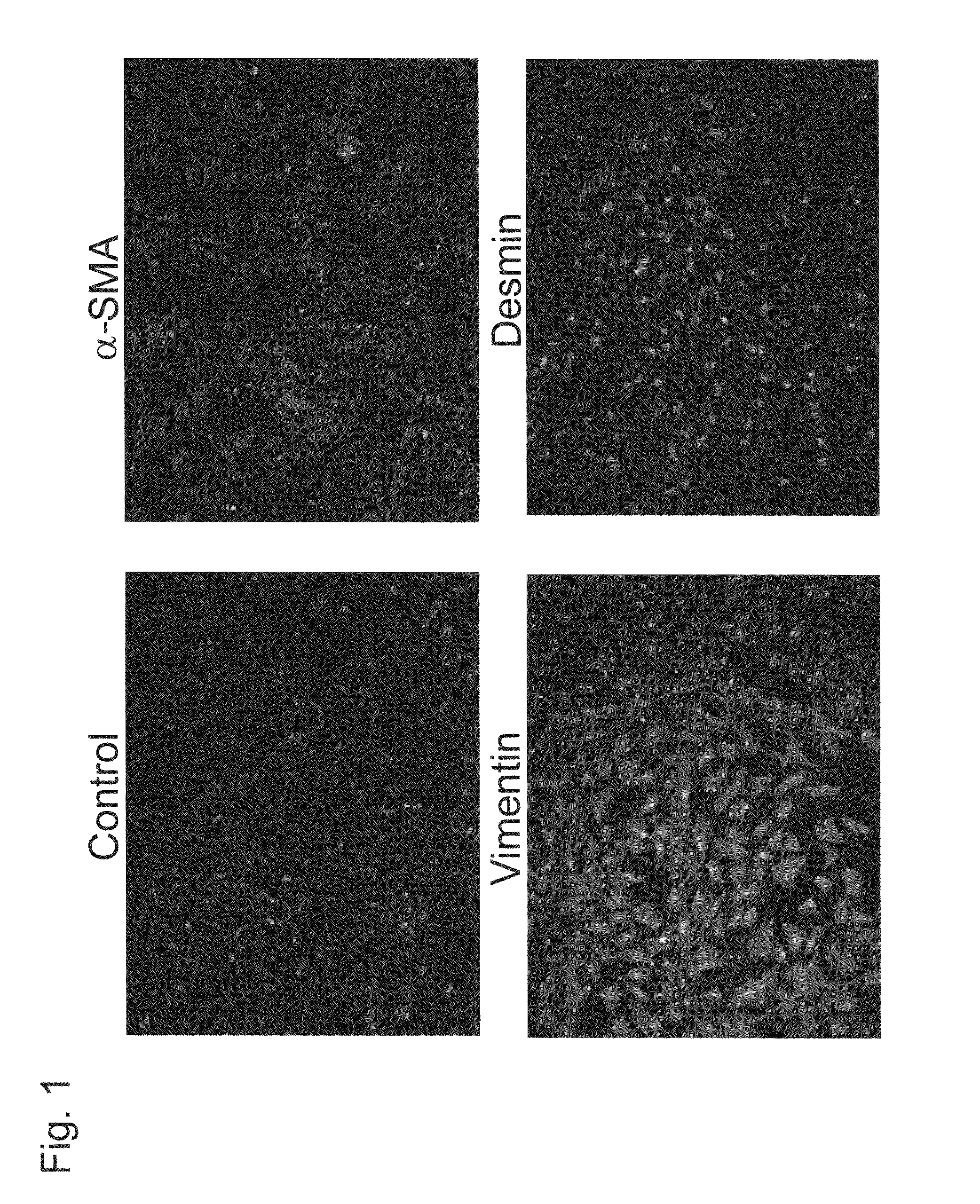Targeting agent for cancer cell or cancer-associated fibroblast
a cancer cell or cancer-associated fibroblast technology, applied in the direction of viruses, drug compositions, dna/rna fragmentation, etc., can solve the problems of nausea and vomiting, hair loss, myelosuppression, and no delivery method is satisfactory, etc., to suppress the activity or growth, suppress the advance, and efficiently deliver to
- Summary
- Abstract
- Description
- Claims
- Application Information
AI Technical Summary
Benefits of technology
Problems solved by technology
Method used
Image
Examples
example 1
Separation of CAFs
[0109]Cancer tissue or peripheral normal tissue (normal tissue separated from a site spaced from cancer tissue by at least 2 cm) removed from a colon cancer patient was finely cut into 1×1×1 mm, then centrifugally washed with PBS twice, and the pellets were cultured in a culture liquid (DMEM (Dulbecco's Modified Eagle Medium) containing collagenase type I (225 U / ml), hyaluronidase (125 U / ml), 10% FBS (fetal bovine serum), streptomycin / penicillin) for 24 hours. Subsequently, the supernatant was aspirated, and culturing was continued after changing the liquid culture for 10% FBS / DMEM. When the cultured cells were immunostained with an FITC labeled antibody with respect to α-SMA, which is a marker for CAFs, and vimentin, which is a marker for mesenchymal cells, α-SMA was detected only in cancer tissue-derived cells, and it was confirmed that these cells were CAFs (see FIG. 1). Vimentin was positive for cells derived from either tissue, and desmin, which is a marker fo...
example 2
CAF Tumor Growth Activity
[0110]A 6-well plate was seeded with CAFs or normal fibroblasts obtained in Example 1 at a density of 1×105 cells / well and cultured with 10% FBS / DMEM, the liquid culture was replaced with 0.5% FBS / DMEM in a confluent state on the third day, and the liquid culture was seeded with colon cancer cell line M7609 cells (2×105 cells), and coculturing was carried out for 7 days. The number of M7609 cells was counted with a Coulter counter (Beckman) at 0 days and on the 3rd and 5th days. The results are given in FIG. 2. This shows that CAFs promote the growth of cancer cells.
example 3
Preparation of siRNA
[0111]Three types of siRNA targeted at gp46 (GenBank Accession No. M69246), which is a rat homologue of human HSP47, and a random siRNA control were purchased from Hokkaido System Science Co., Ltd. Each siRNA consists of 27 bases overhanging on the 3′ side, and the sequences are as follows.
[0112]
Sequence A:(sense, SEQ ID NO: 1)5′-GUUCCACCAUAAGAUGGUAGACAACAG-3′(antisense, SEQ ID NO: 2)5′-GUUGUCUACCAUCUUAUGGUGGAACAU-3′Sequence B:(sense, SEQ ID NO: 3)5′-CCACAAGUUUUAUAUCCAAUCUAGCAG-3′(antisense, SEQ ID NO: 4)5′-GCUAGAUUGGAUAUAAAACUUGUGGAU-3′Sequence C:(sense, SEQ ID NO: 5)5′-CUAGAGCCAUUACAUUACAUUGACAAG-3′(antisense, SEQ ID NO: 6)5′-UGUCAAUGUAAUGUAAUGGCUCUAGAU-3′Random siRNA:(sense, SEQ ID NO: 7)5′-CGAUUCGCUAGACCGGCUUCAUUGCAG-3′(antisense, SEQ ID NO: 8)5′-GCAAUGAAGCCGGUCUAGCGAAUCGAU-3′
[0113]Furthermore, siRNA labeled on the 5′ side with the fluorescent dye 6′-carboxyfluorescein (6-FAM) was also prepared.
PUM
| Property | Measurement | Unit |
|---|---|---|
| diameter | aaaaa | aaaaa |
| diameter | aaaaa | aaaaa |
| concentration | aaaaa | aaaaa |
Abstract
Description
Claims
Application Information
 Login to View More
Login to View More - R&D
- Intellectual Property
- Life Sciences
- Materials
- Tech Scout
- Unparalleled Data Quality
- Higher Quality Content
- 60% Fewer Hallucinations
Browse by: Latest US Patents, China's latest patents, Technical Efficacy Thesaurus, Application Domain, Technology Topic, Popular Technical Reports.
© 2025 PatSnap. All rights reserved.Legal|Privacy policy|Modern Slavery Act Transparency Statement|Sitemap|About US| Contact US: help@patsnap.com



